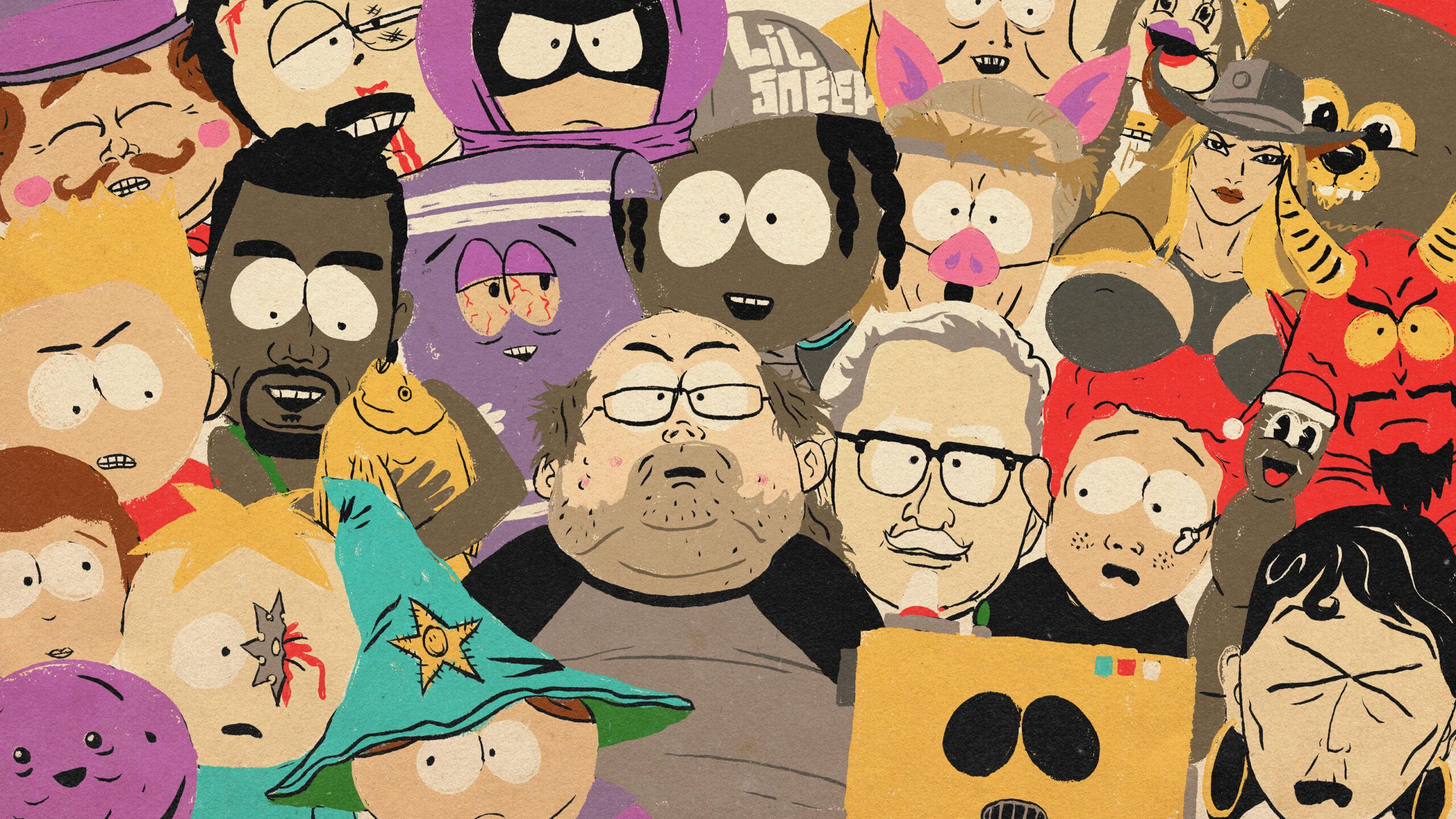The Ringer’s Top 40 Episodes of ‘South Park,’ Ranked
The crudest animated show about a bunch of kids comes to HBO Max on Wednesday. To celebrate, we ran through our favorite episodes, from “Fishsticks” to “Casa Bonita” to “Imaginationland” and all points in between.It’s all there in the opening scene of the first episode of South Park. After the brief theme song performed by Primus and a gonzo credit sequence, we’re introduced to four crudely animated third-graders—Stan Marsh, Kyle Broflovski, Kenny McCormick, and, of course, the demagogue child-tyrant Eric Cartman—as they sing “School Days,” an innocent song from 1907 about an older couple looking back on their youth. They’re interrupted by Kyle’s brother Ike, whom Cartman calls a dildo. “What’s a dildo?” Stan asks. The boys—with the possible exception of Kenny, who’s muffled by his trademark orange hood—have no answers. But it doesn’t stop them from throwing the word around.
In the nearly 23 years since that pilot debuted on Comedy Central in August 1997, 306 additional episodes of South Park have aired, most blending the pure and profane in a way foreshadowed by that opening minute. (Of course, the episode’s title, “Cartman Gets an Anal Probe,” also signaled much of what was to come.) The children are our eyes into the bizarre, titular Colorado town, which series creators Trey Parker and Matt Stone use to dissect the world we live in. They’re often the smartest people in a reactionary town frequently visited by vapid celebrities. But they’re just 10 years old, and South Park consistently reminds us of that, whether it’s through their love of World of Warcraft, or Stan getting his heart broken for the first time, or their inability to understand words best suited for the bedroom.
South Park, however, aims to be more than kids being kids and unearthing new obscenities (though that was certainly a large part of its early appeal). The show has been praised and condemned in equal part for its handling of current events and social issues ranging from Scientology to China to Osama bin Laden to virtually anything that’s appeared in the headlines in the past two decades. That’s a result of the show’s famously nimble approach, which allows it to produce some episodes in as quickly as three or four days. Seemingly no one and nothing has been exempt from Parker and Stone’s sometimes savage satire. Look no further than the Season 9 episode “Best Friends Forever” to see their nihilistic views on display: After Kenny’s umpteenth death sparks a right-to-die debate that echoed the Terri Schiavo case—the episode aired hours before Schiavo passed away—Kyle declares “Cartman’s side is right, for the wrong reasons. But we’re wrong, for the right reasons.” In Parker and Stone’s world, everyone has a point, or perhaps no one has one at all. It’s not surprising that Stone once said, “I hate conservatives, but I really fucking hate liberals.”
That approach has not been without controversy. The show has handled gender issues clumsily since the boys’ teacher, Mrs. Garrison, transitioned early in the show’s run, and mocked trans athletes as recently as 2019. Eric Cartman is racist and xenophobic to his core, and while his ignorance is supposed to be the butt of the joke in many cases, writers dating back to David Margolis in 1999 have argued the popular character has helped normalize anti-Semitism. South Park as a whole has never been adept at addressing racial issues—the fictional town’s lone Black student is named Token Black, and that’s just one of the show’s many offenses. That isn’t to say that Parker and Stone haven’t successfully walked a fine line on sensitive issues on occasion, however: The Season 11 episode “With Apologies to Jesse Jackson,” which was made in response to comedian Michael Richards shouting racial epithets at Black hecklers, featured 42 uncensored uses of the N-word. “With Apologies” was later praised by the NAACP-connected group Abolish the “N” Word, whose cofounder said, “This show, in its own comedic way, is helping to educate people about the power of this word and how it feels to have hate language directed at you.”
On June 24, every episode of South Park arrives on HBO Max, with its warts, genius, and all else that comes with it. Revisiting now is sometimes uncomfortable, and occasionally revelatory. It still features the juvenile jokes that slayed teenagers, the high-brow plots that blew the college kids’ minds, and, at its center, the four precocious boys that so many fell in love with when it debuted in the late ’90s. To mark the occasion, The Ringer has ranked our top 40 episodes of South Park. We’ll do our best to not use the word “dildo” again. —Justin Sayles
40. “You Have 0 Friends” (Season 14, Episode 4)
This episode premiered in 2010, way before Facebook was helping to convince your dumb uncle that government shadow elites are secretly using alien technology from another dimension to remotely lobotomize registered AARP members. There was a time when Facebook was simply annoying, and the pressure to begin living your life online hit communities across America like a tidal wave. In this episode, Stan reluctantly succumbs to that pressure, simply to placate the people in his life. All of a sudden, everyone around him begins oversharing inane personal tidbits and demanding daily positive affirmations in the form of likes, comments, and even pokes. Human interactions become commoditized and digital personae become inextricably linked with IRL selves. In addition to being a rather prophetic episode, “You Have 0 Friends” is also really funny. Cartman hosts a Mad Money ripoff TV show that charts the value of Facebook users as if they’re merely stock shares that can be easily jettisoned without remorse. Randy Marsh awkwardly confronts Stan, asking why he hasn’t friended his own father. When Stan gets fed up and tries to delete Facebook, he gets “sucked into Facebook,” a digital realm resembling Tron if it were somehow even less welcoming. There’s an unfortunate amount of South Park that hasn’t aged well ,,, but “You Have 0 Friends” hasn’t lost a step. —Matt James
39. “AWESOM-O” (Season 8, Episode 5)
What starts as another prank played on Butters turns into a nightmare for Cartman. The idea was simple: dress up as a robot called Awesom-O 4000, befriend Butters, and trick him into revealing his deepest secrets. It starts off great, until Butters lets slip that he has a video of Cartman dressed up as Britney Spears kissing a cardboard cutout of Justin Timberlake. Fearful this could get out, Cartman begins spending every waking minute with Butters, who really believes Awesom-O is an actual robot. On a trip to Los Angeles, a starved Cartman is somehow roped into pitching movies to a studio, and those ideas result in hundreds of new Adam Sandler films. The government gets word of this and kidnaps Awesom-O to reprogram it as a weapon. Eventually the jig is up, all because Cartman farted and robots technically don’t fart. It’s one of Cartman’s most ridiculous pranks, and while it might not have been the most successful, it did give us Puppy Love, a movie where Adam Sandler falls in love with a girl but the girl is actually a golden retriever. —Sean Yoo
38. “Raisins” (Season 7, Episode 14)
After Wendy breaks up with Stan, the boys take him to a juvenile Hooters-like restaurant called Raisins, and while I’ve never been inside a Hooters—apparently, they serve great wings—I trust that the writers of South Park captured the full experience with a sports bar atmosphere and heavily made-up waitresses, who utter what one can only assume is the company line: “I’m so glad you guys came in—everyone in here is such a loser, but you guys seem really cool.” From there, Butters becomes infatuated with Raisins waitress Lexus, while Stan falls deeper into his post-breakup depression and joins the goth kids. But beneath the ridiculous, somewhat uncomfortable Hooters gag, there’s true emotion in this episode—an understanding that’s relatable to anyone who’s ever experienced the intense emotions that follow a breakup or unrequited love. While trite, the exchange between Stan and Butters toward the end ties the perfect bow on another lovingly absurd episode of South Park:
Stan: Huh? But you just got dumped!
Butters: Well, yeah, and I’m sad, but at the same time, I’m really happy that something could make me feel that sad. It’s like, it makes me feel alive, you know? It makes me feel human. The only way I could feel this sad now is if I felt something really good before. So, I have to take the bad with the good. So I guess what I feel is, like, a beautiful sadness.
37. “Night of the Living Homeless” (Season 11, Episode 7)
South Park doesn’t punch down as much as it punches in every direction. In this Night of the Living Dead parody, the town’s growing homeless population is occasionally the subject of the joke—a running gag has Cartman wanting to jump a few homeless people on his skateboard—but the real digs are aimed at the town’s residents, who are frightened by the sudden influx of beggars. The episode begins with the town council trying to figure out how to make use of the homeless (Randy suggests using them for tires, which isn’t too far off what some communities have tried to do in the not-so-distant past). Before long, the residents are unable to do anything, frozen by guilt and unable to maneuver through the hordes of people who have overrun the streets and public places. The boys eventually visit the neighboring town of Evergreen—which, it turns out, successfully ended its homeless problem by convincing its beggars to move to South Park. That gives the fourth-graders an idea: The way to reclaim the town is to convince the homeless to make their way to the Los Angeles area. The plan works (thanks to a modified version of “California Love”), and the residents of South Park rejoice. The homeless are out of sight and out of mind, and the town can get back to business as usual, but that ignorance-is-bliss approach may be one of the show’s most damning indictments of all. —Sayles
36. “The List” (Season 11, Episode 14)
This is one of the most underrated South Park episodes, in my humble opinion. When the girls create a list ranking the hottest boys in school, Kyle gets depressed when he discovers he’s been voted the ugliest. What seems like your standard elementary school kiddy drama slowly turns into a political story about corruption and lies as Stan and Wendy investigate the truth of the voting process within the Pleases and Sparkles Committee. When Stan and Wendy finally discover the truth and explain it to Kyle, Bebe appears … with a gun. —Jason Gallagher
35. “Fat Butt and Pancake Head” (Season 7, Episode 5)
The absurdity and downright brazenness that gives South Park its reputation is on full display in “Fat Butt and Pancake Head,” the Season 7 episode that viciously parodies onetime celebrity megacouple Jennifer Lopez and Ben Affleck. Cartman dresses his hand up as Jennifer Lopez for a cultural diversity day presentation, and performs what is essentially an offensive ventriloquist act, much to the chagrin of Kyle, who has spent weeks preparing for his own, more appropriate presentation on Latinx culture. As expected, Cartman comes out victorious over Kyle, and is awarded a gift certificate to the mall, which he spends on a music video for his hand dressed as Jennifer Lopez. Eventually, Cartman’s hand replaces the real Jennifer Lopez, both careerwise and in her relationship with a dumb, lovesick Ben Affleck. However, the real magic of this episode occurs within the last few moments, when it’s revealed that Cartman’s hand was never another Jennifer Lopez, but instead a drifter named Mitch Conner. Fitting to the entire plot, this animated deus ex machina is absolutely nonsensical, but it’s also one of the funniest endings in the show’s history. —Wedemeyer
34. “Cancelled” (Season 7, Episode 1)
A few months ago, I was watching America’s Next Top Model. What a show. Just pure reality TV cooked up in a mad genius’s lab (probably Tyra’s). Every element of that show is done up to the absolute most, to the point that contestants end up looking like a bad imitation of actual humans. Watch literally any episode and you’ll see what I mean. So there I was, watching trashy television, thinking to myself, “These people honestly are acting like aliens. What if we’re in a reality show for aliens, man?” It was my great idea, my million-dollar script. Fast-forward a few weeks and Ringer editor Justin Sayles asks me to write about South Park episodes, including this one—a super-aware meta-commentary about the show itself, society, and TV culture, that right before it gets too smart dives deep into the dumb end—which is about Earth being a reality TV show for aliens. No idea is original. “South Park did it” is going to become the new “The Simpsons did it.” —Mose Bergmann
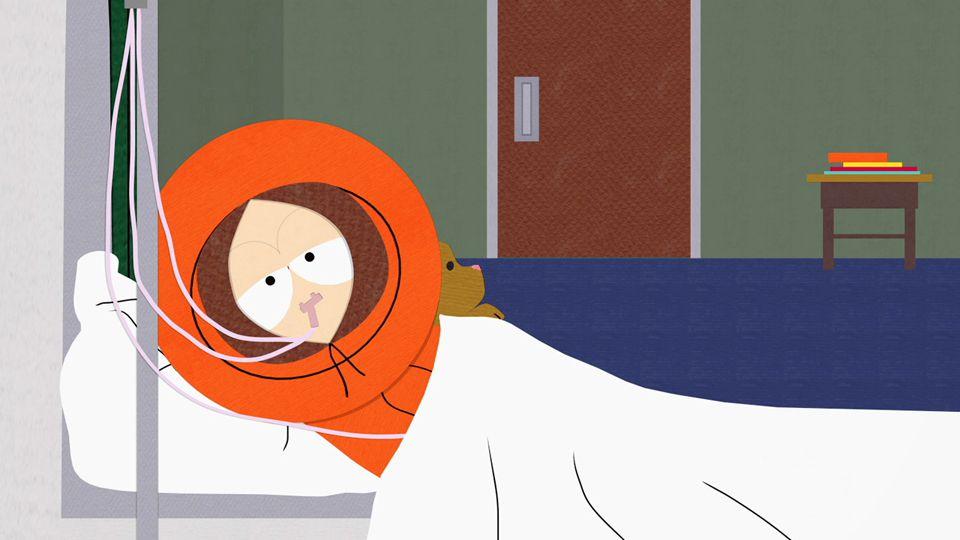
33. “Kenny Dies” (Season 5, Episode 13)
By Season 5, Parker and Stone had grown sick of the show’s longest-running gag: the many deaths of Kenny McCormick. So they devised a proper sendoff for the orange-hooded character. The resulting episode is a mostly tender half-hour, in which Stan grapples with the purpose behind god’s plan and Cartman, in hopes of getting a stem-cell research ban overturned, leads Congress in a rendition of Asia’s “Heat of the Moment.” Unfortunately, Cartman’s plan doesn’t work (at least for saving Kenny; he does use his aborted fetuses to clone a Shakey’s Pizza). Fortunately for the show, however, the creators reversed their decision late in Season 6 and brought Kenny back full time. He’s died in the show only sparingly since—and even revealed the source of his immortality later in the show’s run. —Sayles
32. “Gnomes” (Season 2, Episode 17)
Great episodes are sometimes really just great moments. “Gnomes” as an episode is about a group of underpants-stealing gnomes who infiltrate Tweek’s bedroom—while Tweek’s dad, a monologue-happy proprietor of a small coffee shop, goes to war with Harbucks, a corporate coffee company that has his balls in a “vise grip” and a “salad shredder.” It’s about big business and capitalism and underpants. But “Gnomes” as a moment boils down to this:
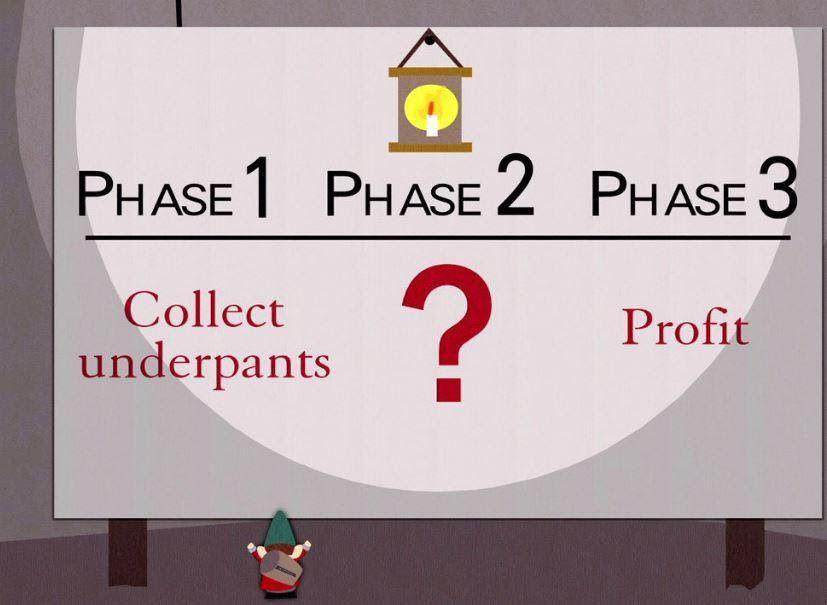
The image has been used to explain MoviePass, political movements, and Elon Musk’s takeover of Mars (Elon Musk used it on himself). It’s a great example of South Park’s knack for allegory, an image that succinctly speaks to the harebrained schemes that have defined so much of 21st-century industry—and it’s, rightfully, the lasting legacy of “Gnomes.” I still don’t know what Phase 2 is. Does anyone? Does it even matter? —Andrew Gruttadaro
31. “Christian Rock Hard” (Season 7, Episode 9)
Not long after bands like Metallica were getting roasted for complaining about music piracy, a local garage band in South Park named Moop was going through some creative differences. Cartman believes so much in his vision that he bets the other members of the band that he can make a platinum-selling album before they do. And what’s the easiest way for Cartman to do that? By starting his own Christian rock band called Faith + 1 and singing about getting on his knees, pleasing Jesus, and feeling his salvation all over his face. —Gallagher
30. “Cartmanland” (Season 5, Episode 6)
Cartman inherits $1 million from his grandmother and uses it to buy a theme park that only he can use. His decision to ban everybody sparks outrageous demand, and when he’s forced to open up the park to the public to pay for security and maintenance workers, he generates massive profit. Cartman’s newfound wealth and happiness causes Kyle to lose faith in God and develop a hemorrhoid that nearly proves fatal, up until Cartman loses everything out of impatience and sheer stupidity.
This is one of the most basic premises of any South Park episode. It’s also oddly realistic. Change theme park exclusivity to concert exclusivity, and this isn’t far removed from what happened with the Fyre Festival. —Ben Glicksman
29. “Margaritaville” (Season 13, Episode 3)
To understand consumerism and the collapse of the American housing market in the late aughts, many people have turned to Academy Award–winning film The Big Short, while others, such as myself, have sought truth in South Park’s Emmy-winning “Margaritaville.” In this episode, South Park is turned into a biblical setting after a recession strikes its residents, who have come to view the economy as a vengeful god after Randy Marsh takes it upon himself to berate his neighbors for their frivolous spending. This comes after one of the episode’s highlights, when Randy explains the reasoning of South Park’s economic downturn to Stan, casting blame on materialism and people who’ve taken out loans to spend on nonessential items, all the while using his Margaritaville-branded blender to fix himself a drink. In the end, Kyle takes it upon himself to solve the town’s economic woes, only to see his credit be attributed to President Obama. Like most of South Park’s best episodes, “Margaritaville” takes a culturally relevant subject and presents it in a digestible way using its trademark humor. —Wedemeyer
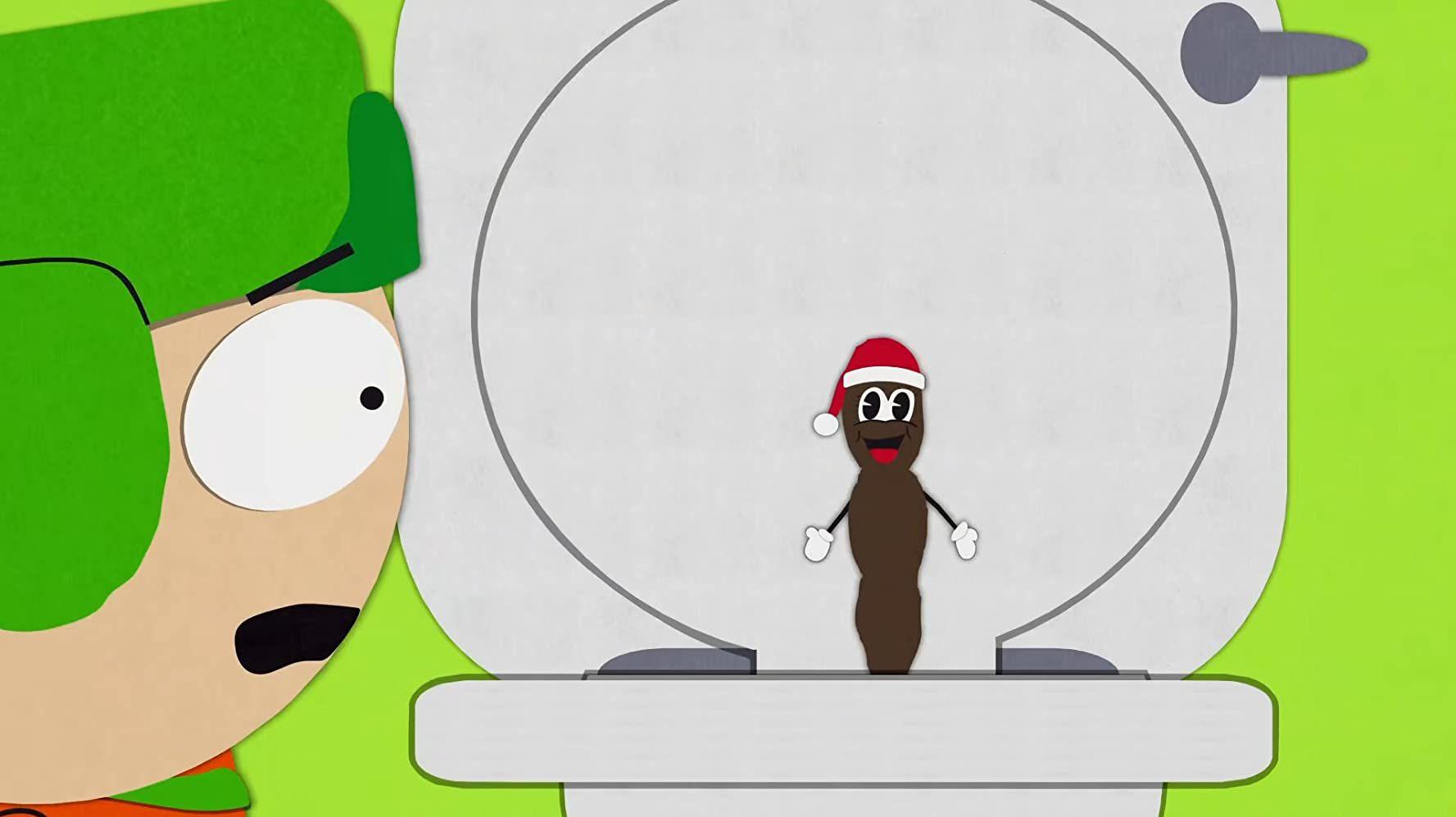
28. “Mr. Hankey, the Christmas Poo” (Season 1, Episode 9)
I can’t begin to explain how incendiary a singing piece of excrement was in 1997. I can remember my entire extended family, crowded in a living room on Christmas Eve, keeling over as we watched a poop bounce around a room (leaving a trail behind him) and sing about “festive buns” and levels of, um, corniness. My uncle cried that night. It may seem mild now—stupid, even—but that’s the point. It seems that way in 2020 only because South Park has pushed boundaries so far in the intervening years. And it started, in part, with Mr. Hankey. —Gruttadaro
27. “Stupid Spoiled Whore Video Playset” (Season 8, Episode 12)
In 2004, the show went in on Paris Hilton and the celebration of socialite celebrity culture. After Hilton arrives in South Park, she watches her dog die by suicide, tries to buy Butters for $200 million, and challenges Mr. Slave to a “whore-off” in the middle of town. When later asked about the episode, Hilton said, “I haven’t seen it, but when people copy you, that’s like the most flattering thing.” —Glicksman
26. “You’re Getting Old” (Season 15, Episode 7)
One of the beauties of animated sitcoms is the characters never get old, unless the creators want them to. Bart Simpson will forever be 10, and his sisters will be 8 and 1. South Park has occasionally played with this: At one point in Season 4, the boys enter fourth grade. Time appears to move slowly in South Park, but unlike for its peers, it moves.
This Season 15 episode tackles the idea of aging in a more philosophical sense. Stan turns 10, and everything starts to sound, look, and taste like shit—literally. A doctor diagnoses Stan with a case of “being a cynical asshole,” and after he ruins an outing to X-Men: First Class, they want nothing to do with him.
While you can’t stay young forever, the episode’s B-plot revolves around what happens when one tries to. Randy, who grits his teeth and pretends to like the tween-wave music the kids are enjoying, eventually begins playing his own music under the moniker “Steamy Ray Vaughn.” He becomes a walking Hard Times punch line: too oblivious to realize he’s too old to be here.
“You’re Getting Old” ends on a sad note—Randy and Sharon’s divorce and Stan’s new, dispiriting life set to “Landslide”—but I choose to remember it for its happy moments, like Duck President. Sometimes, shit just works. —Sayles
25. “You Got F’d in the A” (Season 8, Episode 4)
This gruesome spoof of the 2004 film You Got Served focuses on Butters and his extreme misfortune. After Randy is hospitalized for being served, Stan assembles a ragtag group to avenge his father in a dance-off with kids from Orange County. But he needs a fifth member, and someone suggests Butters, who was once a state tap-dancing champion. But Butters refuses to join because of a prior incident that haunts him. We get a flashback of his last competition, where he’s dancing to the tune of “I’ve Got Something in My Front Pocket for You,” before his shoe flies off into the rafters and kills eight people—or 11, depending on how you count. Stan and Co. are unable to convince Butters, and instead enlist the help of Jeffy the duck, who injures his leg the day of the performance. Butters comes to save the day, but ends up reliving his past horror again, when he ends up killing the entire Orange County team the same exact way he killed all those other people. By a technicality, Team South Park wins, and a traumatized Butters is praised as a hero. Someone definitely got served in this episode; we’re just not exactly sure who. —Yoo
24. “Towelie” (Season 5, Episode 8)
Towelie is a prototypical rudderless stoner character. Outside of the distinction of being the first stoner to be a sentient towel, there’s no innovation in stoner humor to be found here. He’s a dumb character and Parker and Stone directly acknowledge that with the fake Towelie merch commercial that aired with this episode. The meta-joke of immediately trying to monetize such a cheaply crafted character seemed to give them the green light for all the low-hanging fruit that is Towelie humor. All that being said, when a towel with a high-pitched voice sheepishly asks “You wanna get high?” it’s really fucking funny. And it’s as funny as it is because it’s so egregiously stupid.
This episode is mostly remembered for Towelie’s debut, but its through line hasn’t lost any relevance in the past 18 years. The boys spent the entirety of this episode completely apathetic to every facet of life outside of playing their new Okama Gamesphere. Throughout all the gun fights, parachuting, infiltration of secret bases, and thick exposition, the boys simply do not care about anything they’re doing. They’re living out a video game and yet they’re too blinded by their desire to play a video game to enjoy any of it. For all the Guitar Hero wizards with dusty out-of-tune real guitars, this is a gut punch. —James
23. “All About Mormons” (Season 7, Episode 12)
South Park is arguably at its best when it satirizes organized religion. There may be no better example than “All About Mormons,” in which a devout Morman family moves to South Park, befriends the Marshes, and teaches them about Joseph Smith and the Book of Mormon. “All About Mormons” features a singsong story about the roots of the Church of Jesus Christ of Latter-day Saints, including Joseph Smith’s tale of being visited by an angel, his use of gold plates and seer stones to translate another new testament of the Bible, and Lucy Harris’s suspicion of Smith. Trey and Matt would later explore the religion further in their play The Book of Mormon, which won nine Tonys, including Best Musical. —Wedemeyer
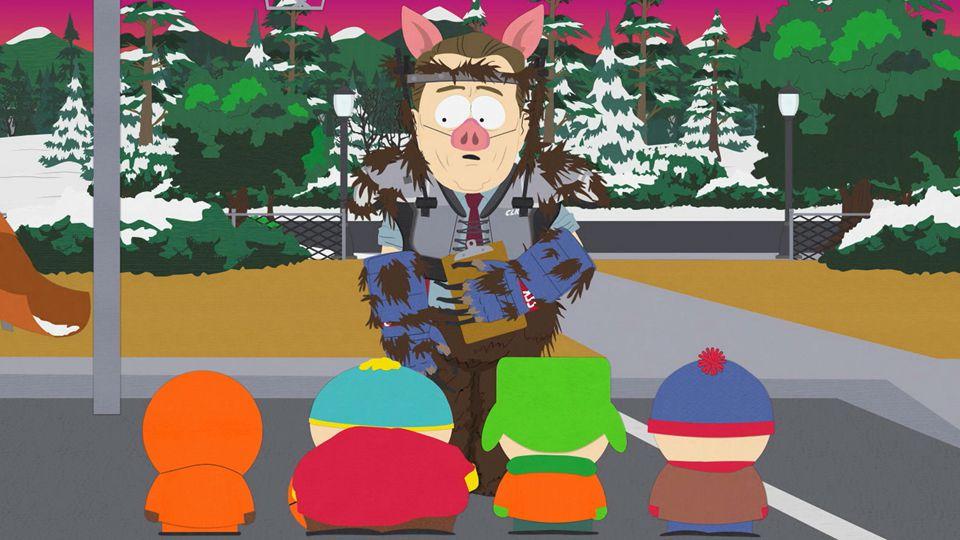
22. “ManBearPig” (Season 10, Episode 6)
“I’m totally cereal” is the defining quote from this episode, in which Al Gore is portrayed as a rabid man on the hunt for the episode’s titular creature. It’s a not-so-subtle allusion to Gore’s climate change work. And like in the mid-2000s, not many people here seemed to listen to him. (Though Parker and Stone would later atone for this in a pair of Season 22 episodes, aptly titled “Time to Get Cereal” and “Nobody Got Cereal?”) Elsewhere in “ManBearPig,” in classic Cartman fashion, he thinks he finds some gold in a cave that the boys believe to be housing ManBearPig. Cartman decides to hide the treasure by swallowing it all. Then he shits it all out at the end of the episode. All that’s gold in South Park doesn’t always glitter. —David Lara
21. “Fishsticks” (Season 13, Episode 5)
The best South Park episodes usually have some sort of cultural impact, and “Fishsticks” might have had the most significant in the show’s history. The episode revolves around a joke Jimmy comes up with, with minor help from Cartman:
Do you like fish sticks?
Yeah.
Do you like putting fish sticks in your mouth?
Yeah.
Well, what are you, a gay fish?
The joke goes viral, with every late-night host repeating it on their respective shows. It’s also beloved and understood by everyone except one person, Kanye West. In a quest to fully understand the true meaning of the joke, Kanye goes on a rampage, taking his anger out on people, even killing Carlos Mencia in the process. After talking with Jimmy and Cartman, Kanye eventually has an epiphany, believing that he is a gay fish. The episode concludes with Kanye embracing his new identity in a music video remixing his song “Heartless,” in which he makes love to a fish. The day after the episode aired, Kanye wrote a blog post that began with, “SOUTH PARK MURDERED ME LAST NIGHT AND IT’S PRETTY FUNNY. IT HURTS MY FEELINGS BUT WHAT CAN YOU EXPECT FROM SOUTH PARK!” The post ends with Kanye examining his own ego and his image. (A year later, on “Gorgeous,” he’d rap: “Choke a South Park writer with a fish stick.”) Who would’ve ever thought a dumb joke on a show like South Park could help change someone like Kanye? —Yoo
20. “The Return of the Fellowship of the Ring to the Two Towers” (Season 6, Episode 13)
As much as South Park is, well, South Park—crass, gross, stupid—it’s also a show about kids. Sometimes I almost forget that detail amid all the wildness and social criticism—and also because Kyle, Cartman, Stan, and Kenny have been in fourth grade for about 20 years. That’s why episodes like these are so much fun. “The Return of the Fellowship” lets the kids play make-believe, but it doesn’t turn up the visual style like Parker and Stone did in later episodes like “Good Times With Weapons.” Even though I can’t entirely relate to the story of returning a cursed porn tape, this episode also serves as a special kind of nostalgia point for someone like me, who as a nerdy, LOTR-obsessed kid, would scour the park near the river with my neighborhood friends for the best-looking stick that could be my own Andúril, or some short stubbies to best imitate Legolas’s double blades (nobody ever wanted to be Gimli), to arm myself in imaginary battles. —Bergmann
19. “Major Boobage” (Season 12, Episode 3)
On-screen drug trips always present writers with an opportunity to get deeply weird. Kenny and Gerald’s cat urine-induced psychedelic journeys into a direct rip-off of the obscure misogynistic animated sci-fi film Heavy Metal is supremely weird. If you watched this episode having never seen or heard of Heavy Metal, it must have been a real what the fuck moment for you. For those of us who had vague memories of Heavy Metal (or at least its trailer) tucked away in our brains, it was also a what the fuck moment. They really invested all this time, money, and production effort into this niche referential joke with its roots 20 years in the past? More unbelievable than their commitment to the bit however, is how close the parody is to its source material. They even licensed the use of Heavy Metal’s theme by (former) Eagles lead guitarist Don Felder (which still rips). Some of South Park’s greatest successes are just shining a spotlight on something, getting out of the way, and saying “look at how wild this is.” —James
18. “Cartman’s Mom Is a Dirty Slut” (Season 1, Episode 13)
This episode is one of the earliest and best examples of the show’s constant ability to be smart, self-aware, and amusing in a way that evokes a sort of “funny for us” attitude. Cartman’s search for his real dad uses a classic TV trope with a Rashomon-like story structure, but every time we get a new story shedding new light on the mysterious night of Eric’s conception, there should be a new shocking reveal or twist bringing us closer to the truth. Instead of that, what we get instead is a repeated bludgeoning of the same punch line—the titular fact—about Cartman’s mom’s promiscuity. Eric’s dad could’ve been Chief Running Water, or maybe Chef, but also maybe the 1989 Denver Broncos. While the elements of the slut-shaming in this episode have not aged well, this episode remains emblematic of the way South Park can play with story structures and tropes. —Bergmann
17. “Woodland Critter Christmas” (Season 8, Episode 14)
Christmas is a tradition unlike any other on South Park, which had already gifted viewers classics like “Mr. Hankey, the Christmas Poo” and “Red Sleigh Down” by the time Stan stumbled across the woodland critters in 2004. But this episode is a truly off-the-rails yuletide story involving the Antichrist, a bunny sacrifice, a kidnapped Kyle, and mountain lion cubs performing an abortion. That it all comes from Cartman’s sick mind doesn’t make it any less festive. —Sayles
16. “The Death of Eric Cartman” (Season 9, Episode 6)
Cartman eats all the skin off of every piece of KFC chicken, infuriating Stan, Kyle, and Kenny. The next day the boys decide to completely ignore Cartman and somehow, he ends up thinking he has died. At the center of the episode is poor old Butters, who isn’t in on the joke and is the only friend who engages with Cartman. Butters tries using religious themes like heaven and “heck” and atonement to help Cartman release his soul from the earth. While Cartman is doing good deeds, Butter believes he’s talking to a ghost and his parents send him to a doctor’s office that runs some extremely unconventional tests. When escaped prisoners later hold the Red Cross hostage, Cartman is inspired to save the day with help from Butters. The guys eventually reveal their joke, to the complete shock of both Cartman and Butters, resulting in one of most priceless moments ever on the show. —Yoo
15. “Ginger Kids” (Season 9, Episode 11)
This episode shows the range of South Park. It starts with Cartman ripping into kids with red hair (called ginger kids) in an attempt to annoy Kyle, then transitions into Kyle getting revenge by turning Cartman into an actual ginger kid. The ever-aggrieved Cartman uses that to his advantage and creates the Ginger Separatist movement, which aims to abolish all non-redheads. By the end, the episode turns to horror as the ginger kids begin abducting the others. Ultimately, however, the episode concludes on a strange note for Cartman: a song about unity. —Lara
14. “Casa Bonita” (Season 7, Episode 11)
South Park is at its best not when it’s relying on elaborate plot points or ripped-from-the-headline story lines. Two simple ingredients often make for the perfect episode: a story centered on the eternal conflict between Kyle and Cartman, and one that positions the boys as elementary school kids who like to do elementary-school-kid things. In the case of “Casa Bonita,” it means getting excited about Kyle’s birthday party at a beloved Mexican restaurant chain (a real-life reference from creators Matt Stone and Trey Parker, who frequented the chain growing up in Colorado).
The problem arises when Kyle tells Cartman he’s inviting Butters, not Cartman. The episode features Cartman’s frantic and maniacal efforts to take Butters’s place at the party. It also involves this interaction between Kyle and Cartman, which perfectly encapsulates Cartman’s character, or lack thereof. “That’s not being nice. That’s just putting on a nice sweater,” Kyle says, rebuffing Cartman’s efforts to ingratiate himself to Kyle.
“I don’t understand the difference,” Cartman replies. —Nevins
13. “Guitar Queer-O” (Season 11, Episode 13)
This episode hits close to home because I was so much like Stan and Kyle. My friends and I would get together to play Guitar Hero, and we also took so much interest in classic rock music that we all attempted to learn the actual guitar. So watching this felt like a direct shot at my friends and me and the rest of Guitar Hero culture. Any kid who played the game at one point and felt like they were actual rock stars only to realize that they were just playing a silly video game in the end can relate. (Shout-out to Thad, who was introduced in this episode: “He doesn’t even need a system. He can play guitar hero acoustically.”) —Lara
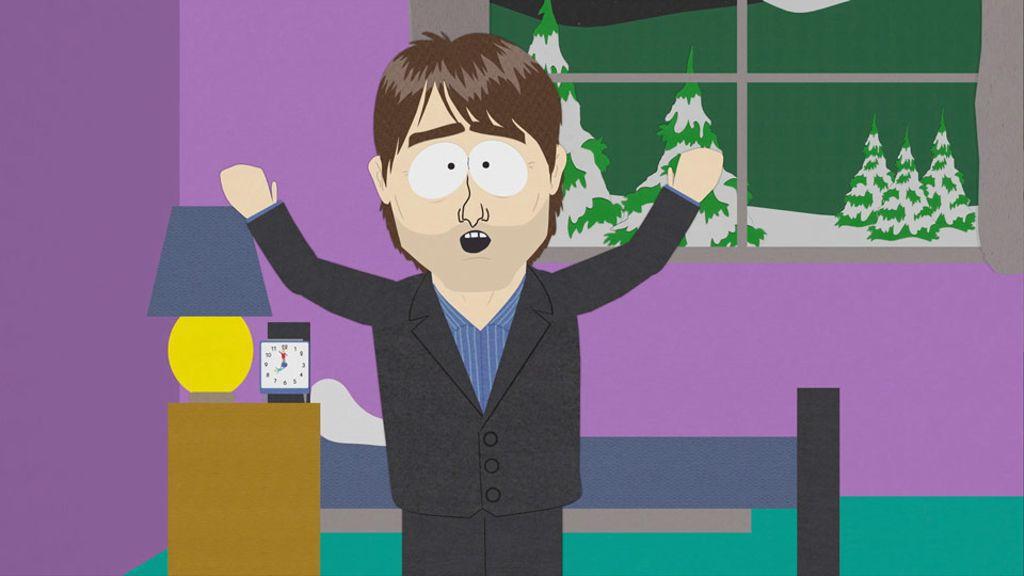
12. “Trapped in the Closet” (Season 9, Episode 12)
Woo boy. It’s the ultimate heat check from Parker and Stone. It’s hard to explain this episode in a sensical and non-litigious way. What’s also hard to explain is how provocative and bizarre it felt when it first aired 15 (!) years ago. The episode’s biggest legacy is how it marked the departure of Isaac Hayes, the longtime voice of Chef and a Scientologist, from the show. Hayes. But that doesn’t adequately explain all that was going on in this episode. It ended with Stan yelling “Go ahead and sue me!” as the end credits rolled with only “John Smith” and “Jane Smith” listed over and over again. Yeah, you really have to see it for yourself. —Nevins
11. “Member Berries” (Season 20, Episode 1)
South Park began experimenting with episode-to-episode continuity in Season 18, but Season 20 was when that approach coalesced. It proved the show remained in a class of its own when making light of a given moment; more than that, it offered striking commentary on the 2016 presidential election, online trolls, and the dangers of nostalgia.
In classic South Park fashion, “Member Berries” took jabs at virtually everyone, and introduced a grape-like fruit that tried to brainwash those who ate it into fetizishing the past. Parts of this seemed harmless enough—“Memba Chewbacca?”—up until the fruit revealed itself to be a hateful and destructive force designed to worsen America’s systemic evils. If you’re always looking backward, you can’t make progress.
At its best, South Park says something important in the dumbest possible way. This episode is an encapsulation. Also, Cartman draws a vagina with balls on his face, because what else would you expect? —Glicksman
10. “Super Fun Time” (Season 12, Episode 7)
When I was in the fourth grade we went to Genesee Country Village, a re-creation of 19th-century life, full of adults pretending to be people from that time. I remember being pretty convinced—like, “Wow! So that’s how a printing press works?!” and “Whoa, no telephones?!” What I never considered was what would happen if I—or someone else in my class; I was too well-behaved for pranks—forced one of these reenactors to acknowledge the present. That’s the premise of “Super Fun Time,” in my mind one of South Park’s best, cleanest episodes: A group of Die Hard–esque criminals (who robbed a Burger King) turn a field trip at Pioneer Village into a hostage situation that isn’t easily resolved because the reenactors refuse to break character. It’s a simple yet absurd concept that yields shocking yet hilarious results; multiple employees die while pretending not to know what a door code is. It’s a bit that never gets old. —Gruttadaro
9. The Game of Thrones Trilogy (Season 17, Episodes 7 through 9)
My favorite genre of South Park episode is the “role-playing” kind—when the adults in town act so insane they fit perfectly into the boys’ imaginary games. In this epic trilogy, the boys are playing Game of Thrones and the town is preparing for a violent winter because Black Friday is coming. Will Randy and the protectors of the mall be able to hold off the vicious hoard of Black Friday shoppers? Can Cartman successfully betray every single one of his friends in the garden of his angry old neighbor? Will anyone survive the Red Robin Wedding? Who will sit on the Iron Thrones of the console wars, Xbox or PlayStation? And most importantly, will George R.R. Martin’s pizza ever actually come for real? —Gallagher
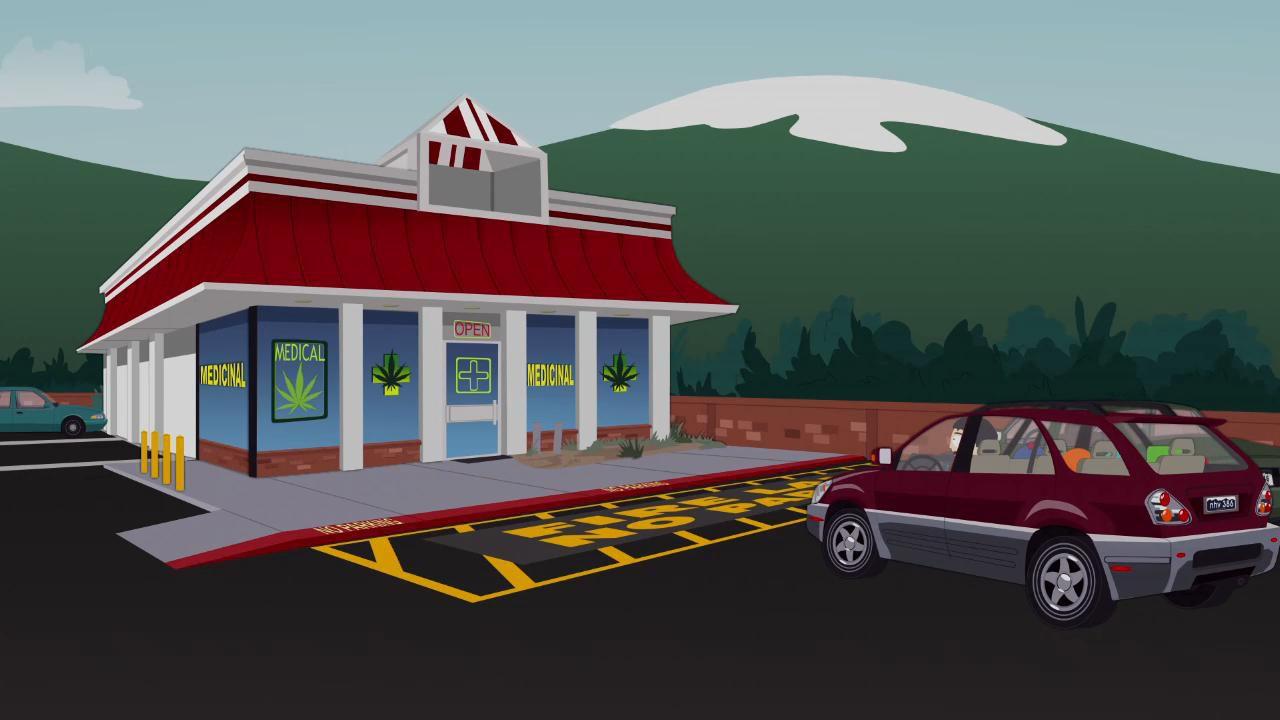
8. “Medicinal Fried Chicken” (Season 14, Episode 3)
Randy Marsh, the idiotic everyman of suburban white America, is the central focus of some of South Park’s most enduring moments. He functions as the slightly exaggerated Florida Man of Colorado, his rudimentary motivations always leading him to new opportunities to make terrible decisions. This is the episode when Randy intentionally exposes his balls to radiation in order to be eligible for medical marijuana. Does it make sense that Randy’s balls swell to the size of bean bag chairs? No, but the resulting visual gags are hilariously arresting. Once you’ve seen Randy shuttling his balls around town in a wheelbarrow or bouncing on them like a gleeful child on a hopping ball, you’re not likely to forget those images.
Cartman, meanwhile, spends this episode becoming the Scarface of an illegal underground KFC supply chain, which is a role that his character seemed destined to play at some point. As Cartman snorts lines of KFC and Randy struggles to fit his enlarged balls through the dispensary doorway, Parker and Stone somehow manage to make a decently cogent argument against unnecessarily criminalizing substances that aren’t definitively harmful. —James
7. The Cartoon Wars (Season 10, Episodes 3 and 4)
There’s nothing like a good diss track. Do you remember where you were when Drake dropped “Back to Back,” or when Pusha-T released “Exodus 23:1”? There’s just something about a beef: the electricity in the air, the pettiness, and the way you can hear the rapper’s snarl or smirk through the song. There’s nothing like it. So imagine the excitement in 2006 when it came to light that one animation titan was devoting a two-episode arc to take shots at another. South Park’s pointed takedown of Family Guy’s randomness-instead-of-actual-jokes quality—with the reveal that a tank of manatees write the show by randomly selecting floating word balls—is genius. It’s basically like if “The Story of Adidon” had subbed out the line “You are hiding a child” for something like “You are hiding a sperm factory that is creating a culture-hopping army.” —Bergmann
6. “The Simpsons Already Did It” (Season 6, Episode 7)
Every modern animated sitcom is directly indebted to The Simpsons. In this Season 6 episode, South Park tackles the inevitable comparisons head-on. Butters, in his evil alter ego Professor Chaos, devises a series of schemes to take down the town: First, he wants to build a device to black out the sun, something that Mr. Burns famously did. Then, he decapitates the town’s statue, which only reminds residents of Bart lopping off Jebediah Springfield’s head. After Butters’s assistant Dougie points out that his third plan—building a faulty monorail and running off with the town’s money—was also a beloved Simpsons plot, Butters snaps and begins seeing traces of Matt Groening’s show everywhere. (One must imagine that Parker and Stone often feel the same way when creating episodes.) But even in a homage to the longest-running scripted prime-time series ever, the South Park creators are able to show what makes their show so different: The episode’s A-plot revolves around Cartman acquiring “sea men” (ugh) to help grow a society of sea people in his bedroom aquarium. It’s a reference to a classic “Treehouse of Terror” plot that saw Lisa accidentally create a new world in a petri dish. But Lisa didn’t have to go through the, um, lengths Cartman did to build a new world. When Cartman explains to Butters at the episode’s end that The Simpsons has done everything already, he’s right. But The Simpsons has never done it like this. —Sayles
5. “The Losing Edge” (Season 9, Episode 5)
“I’m sorry, I thought this was America?!”
Put it on a red hat. Randy Marsh’s outcry at not being allowed to fight all of the rival-team dads at his kid’s baseball games during their playoff run was instantly iconic. A lament that hit home across a certain disaffected subset of white America, it’s Randy’s right to do whatever he wants, because he’s white and middle class. While Randy embarks on a Rocky-like journey across the baseball stadiums of Colorado, literally fighting to uphold the American Dream of unrestricted freedom, the boys are shitting on the great American pastime of baseball, failing upward in their attempts to out-suck their opponents. Sending up a litany of sports movie tropes while giving us an all-time line and also introducing Kyle’s nerdy cousin Kyle, “The Losing Edge” is undeniably one of South Park’s best. —Bergmann
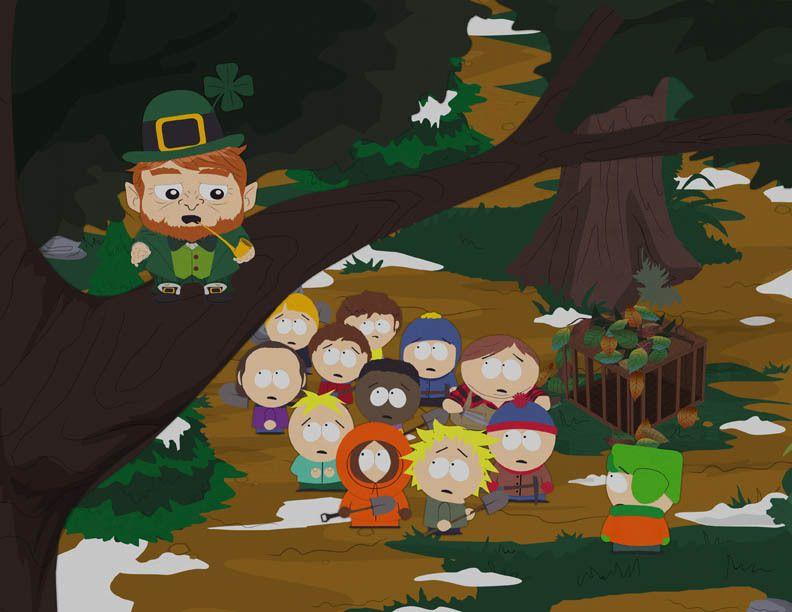
4. “Imaginationland” Trilogy (Season 11, Episode 10-12)
This is Parker and Stone’s opus. If you put the three episodes together and ran them as a feature film, it’d be one of the best animated movies ever. An expert display of topical humor, satire, cultural references, and, crucially, the most contentious and consequential Cartman vs. Kyle battle in the show’s history. —Nevins
3. “Good Times With Weapons” (Season 8, Episode 1)
A master class in animation, at least by South Park standards. After the boys get their hands on martial arts weapons, they live out their ninja warrior fantasies as the episode transitions from the show’s traditional animation to an anime style. Trey Parker sang an original track called “Let’s Fighting Love,” and the episode turns after Butters takes a ninja star to the eye and the boys try to pass him off as a dog to avoid getting in trouble. That’s it. That’s the episode. —Nevins
2. “Make Love, Not Warcraft” (Season 10, Episode 8)
It’s an iconic episode of South Park for its timeliness and ingenuity in incorporating World of Warcraft–style animation. It’s also one of the show’s dumbest episodes ever while simultaneously being a near-perfect ode to the world of MMORPGs. In the episode, the boys take it upon themselves to defeat an evil and powerful character who has killed a majority of the players in the game. The powerful force is a man who has played WoW every hour of every day for a year and a half. Cartman rallies the gang and comes up with a plan to defeat this foe that involves killing approximately 65 million boars, a task that would take more than seven weeks to complete. In a classic montage set to Paul Stanley’s “Live to Win,” the boys eventually accomplish their goal and in turn, become obese, pimply, Rockstar-drinking machines. And thanks to Randy’s help in retrieving the “The Sword of a Thousand Truths,” the boys defeat this great evil force—just to go back to playing the game they love. For how stupid the episode is, Matt and Trey brilliantly mirrored the ethos of WoW while expertly satirizing the simulated high stakes of the game. While the obsession with World of Warcraft may have subsided for most people, the episode still resonates with the audience nearly 14 years after its release. —Yoo
1. “Scott Tenorman Must Die” (Season 5, Episode 4)
“Oh, the tears of unfathomable sadness … ”
It’s been argued that South Park didn’t become what it is until this Season 5 episode. Whether that’s true or not, it is clear that no one realized just how sinister Cartman could be until this point.
“Scott Tenorman Must Die” starts out innocently enough, by South Park standards: Cartman bought some stray pubic hair from the titular red-headed ninth-grader, believing that’s all it took to launch him into puberty. The rest of the boys laugh at him, and he sets out to get his $10 back. One problem: Tenorman is smarter than Cartman. He swindles him out of an additional $6.12 and records a video of him oinking while he begs. Irate, the fourth-grader devises a series of plans to seek revenge—the most promising of which is a convoluted scheme that would have a pony bite off Tenorman’s penis. Nobody is impressed, including the viewer. And then Cartman invites Scott to his Chili Con Carnival …
This episode aired on July 11, 2001. Nineteen years later, I can clearly recall my teenage self’s reaction to its conclusion. I had never seen something that was so shocking and hilarious and twisted all at once. I couldn’t laugh or speak, let alone process the depravity. The whole episode, Cartman had been the rube, getting dunked on by someone five years his senior. At its end, he reveals that he turned the pony plot into a way to have Tenorman’s parents killed by the horse’s owner and then he used their remains to make his chili, which he then fed to Scott. And then he gets Radiohead to show up and mock their biggest fan as he mourns the death of his parents. Really dark stuff, man. But also South Park at its best.
“Dude, I think it might be best for us to never piss Cartman off again,” Kyle says as he takes in what just unfolded. At least someone could muster a thought.
The episode has been compared to Shakespeare’s Titus Andronicus. It also recalls Game of Thrones’ Frey pie. I guess in that regard, South Park is one of the great epics of our time. —Sayles
